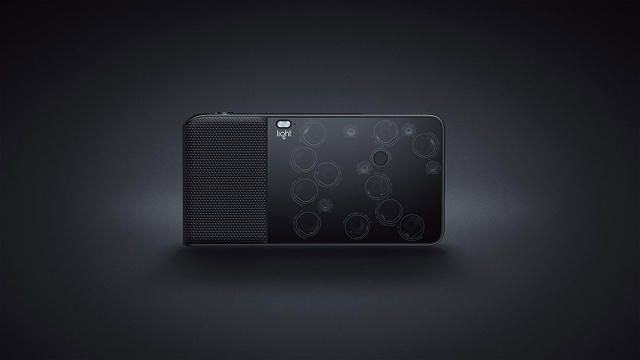New 16-Lens Pocket-Sized Camera Aims To Kick Bulky DSLRs To The Curb
The L16 promises great optical zoom, high resolution, terrific low-light capabilities, and substantial depth-of-field controls.
When shooting photos on the go, 16 lenses are far better than one.
That’s the premise behind the L16, a new fits-in-your-pocket multi-aperture camera that its maker—a well-funded Silicon Valley startup called Light—thinks is going to blow away DSLRs with expensive lenses…not to mention smartphones.
Light unveiled the L16 today, offering it for pre-order at $1,299 but saying it plans on charging $1,699 when the camera ships in late summer of next year. The L16, Light promises, will offer great optical zoom, high-resolution, substantial low-light capabilities, and very fine after-the-fact depth-of-field controls, all without the need for add-on lenses or a multi-thousand-dollar body.

The idea for the L16 stems from what Light’s founders see as a huge gap in today’s photography market. On one hand, you have the committed photographer who doesn’t mind lugging a heavy DSLR around, while on the other, you have the people who rely on their smartphone cameras, millions of which are terrific in some situations, but ultimately have very limited capabilities.

According to Light cofounder and CEO Dave Grannan, the L16 replicates the functionality of a full-frame DSLR with three prime lenses, and a telephoto that zooms from 35 mm to 150 mm.
Under the hood, the camera—which is about the same height and width as an iPhone 6S Plus with a little more thickness—features five 35 mm lenses, five 70 mm lenses with mirrors, and six 150 mm lenses. The mirrors, explained Grannan, fold the optics, and help keep the L16 as compact as possible. It also has an onboard 5-inch LCD high-definition display.
Although the camera features 16 lenses, it uses just 10 when shooting a photograph. The L16’s magic, as Grannan puts it, is in the algorithms it uses to select which 10 to fire.
The key is that the camera was designed to simultaneously capture many different high-res images and then automatically fuse them into a single photograph with a resolution of up to 52 megapixels. That makes the L16 ideal for shooting everything from kids’ soccer games to concerts, the company believes. And thanks to post-processing technology available on users’ computers, it’s also possible to edit photos to change the depth of field after the fact.
In addition, the L16’s exposure time and ISO settings are equivalent to that found on high-end DSLRs, Grannan says, while offering a depth-of-field perspective equivalent to f/1.2 that matches that of very fast, high-quality lenses.
The camera is also capable of shooting 4K video with true optical zoom.
A Second Device
One of the reasons millions of people rely on their smartphones to take between 2 trillion and 3 trillion photos every year is that those devices are already in their pockets, handbags, and backpacks. As has been said many times, the best camera is the one you have with you.
Light is betting that people want to take great photos without lugging around their bulky DSLRs. But the company also acknowledges that the L16, despite being pocket-sized, is yet another device for people to take with them. In that sense, it doesn’t solve the problem of giving users a photo solution without having to carry something other than their phone.

Still, Grannan argues that the L16 is small enough to fit into users’ everyday lifestyle, and that a lot of people will choose the camera given the quality of photos it shoots.
Great photos “are just not going to happen with cell-phone cameras,” Grannan says, and people’s desire to shoot terrific pictures is a “pretty powerful motivator….Yes, this is a different device, but it replaces the kit of gear (of DSLRs and multiple lenses) for someone that wants really great photos.”
Almost no one outside Light has seen the L16, but one independent analyst who’s been briefed about it shared his impressions about what the company has created.
“Overall, I am impressed by Light’s innovative approach to photography, and the science behind the L16’s computational imaging is clearly targeted toward solving a real-world problem for many consumers,” Gap Intelligence analyst Scott Peterson told Fast Company by email. “It is this appeal of ‘quality without hassle’ that the company is banking on to drive adoption of its technology, adding weight to the launch of the L16, as not only a first product from Light, but also as one of the consumer market’s first glimpses at something beyond the traditional imaging industry’s recent offerings.”
Peterson lauded the L16’s “staggering 52-megapixel image output” as establishing a new threshold for consumer cameras. But he worries that the L16’s cost, especially its full retail $1,699 price, “may be its biggest challenge” to capturing significant market share.
“While the L16’s ‘DSLR-killer’ features such as depth-of-field control and its robust 35-150mm equivalent zoom range will undoubtedly resonate well with many,” Peterson says, “consumer understanding regarding the benefits of Light’s technology will be the hurtle to overcome, making Light’s efforts to recruit brand advocacy/awareness critical in its early hour.”
Technology To Be built Into Smartphones
Even as Light is preparing to release the L16 next year, it has also reached a licensing deal with Foxconn—which is making the camera—that allows the Chinese manufacturing giant to build a scaled-down version of Light’s technology into smartphones.
According to Grannan, Foxconn will have the right to incorporate multiple lenses with a focal length of up to 100 mm into its partners’ phones. Light doesn’t have any control over who those partners are, and won’t necessarily have advance notice about such partnerships, but one of Foxconn’s major smartphone partners is Apple.
Grannan said he expects Foxconn to begin shipping Light’s technology in phones by the end of next year. Light will be able to certify that such integrations meet its standards, and will receive a royalty on each phone sold.
On the basis of its technology, as well as its Foxconn deal, Light has secured a total of $35 million in funding. Today, it has 47 employees, mainly based in Palo Alto, Calif. The company is also opening a smaller office in San Francisco’s startup-centric SoMa district.
Social Media
Light knows that photographers are eager to share their photos, and that an on-the-go camera should make that easy. As such, the L16 features onboard Wi-Fi and Bluetooth functionality that enables instant sharing on Instagram, Twitter, Facebook, and other social networks.
The company also plans on offering a premium cloud-storage service, and the ability to push photo to users’ computers or tablet devices. At the same time, iOS and Android apps will allow people to post photos from their smartphones.
[Images: courtesy Light]
Fast Company , Read Full Story
(148)



